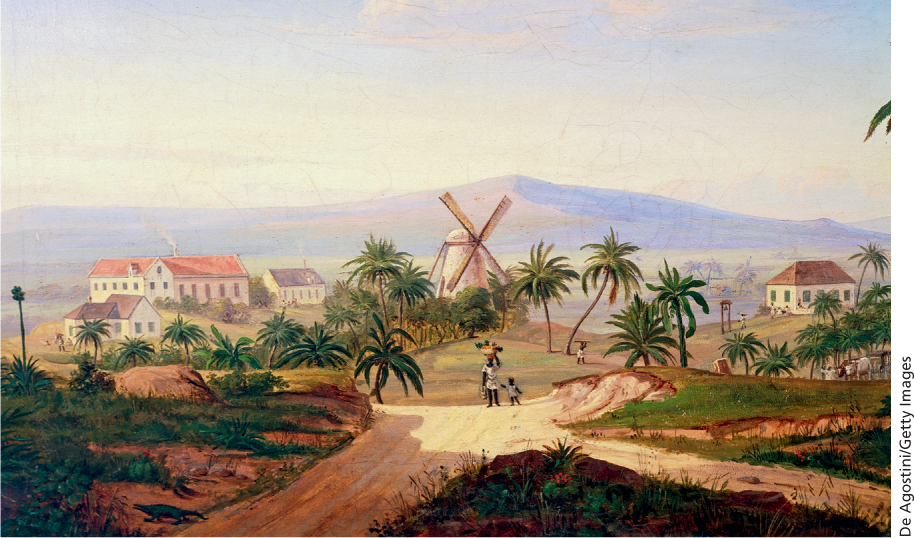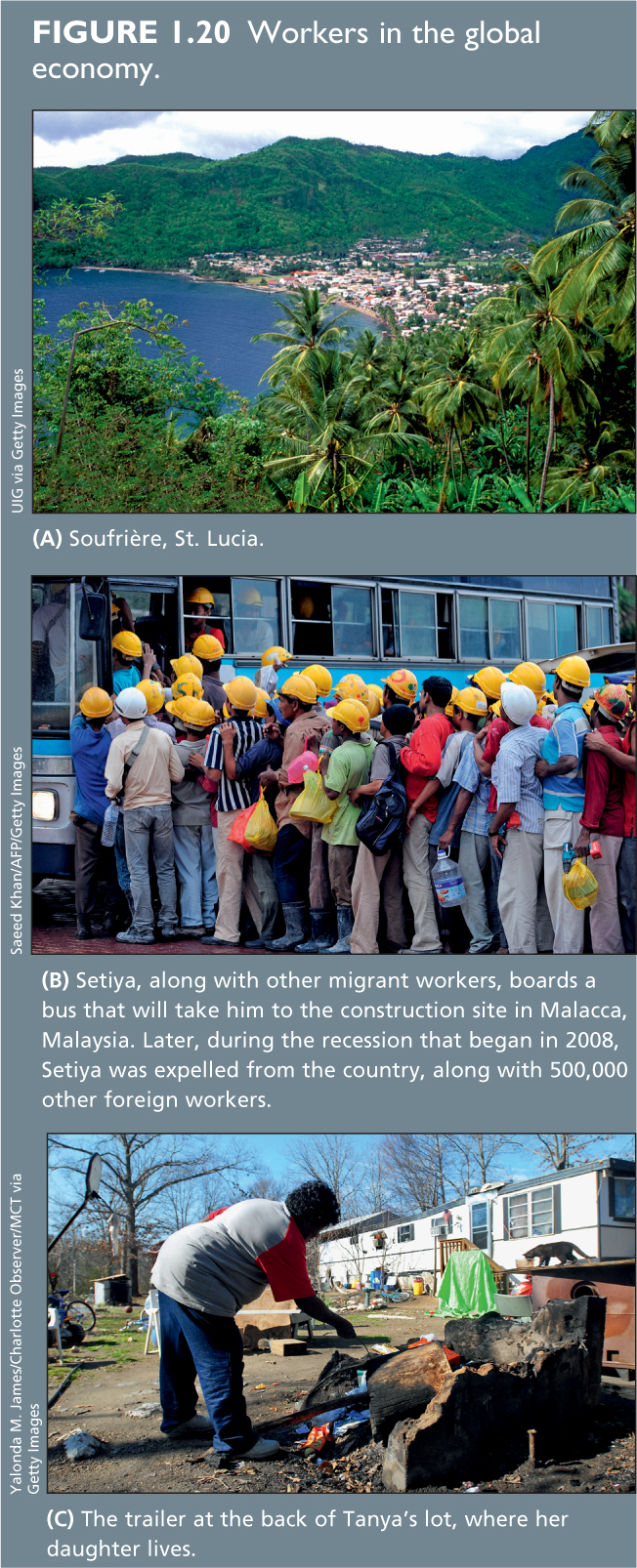1.6 GLOBALIZATION AND DEVELOPMENT
GEOGRAPHIC INSIGHT 2
Globalization and Development: Global flows of information, goods, and people are transforming patterns of economic development. Local self-
The term globalization refers to the worldwide changes brought about by many types of flows that reach well beyond economics. For example, a person’s attitudes and values may be modified because of being in contact with people and ideas from foreign cultures. This contact can be face to face, as a result of increased rates of migration, or virtual, via information technology, the reach of which is expanding along with the global economy. Globalization is the most complex and far-
globalization the growth of worldwide linkages and the changes these linkages are bringing about
Throughout the world, globalization is transforming patterns of economic development as local self-
What Is the Global Economy?
The global economy is the worldwide system in which goods, services, and labor are exchanged. Most of us participate in the global economy every day. For example, books like this can be made from trees cut down in Southeast Asia or Siberia and shipped to a paper mill in Oregon. Many books are now printed in Asia because labor costs are lower there. Globalization is not new. At least 2500 years ago, silk and other goods were traded along the Central Asian Silk Road that connected Greece and then Rome in the Mediterranean with distant China, an expanse of more than 4000 miles (6437 km).
global economy the worldwide system in which goods, services, and labor are exchanged
European colonization was an early expansion of globalization. Starting in about 1500 c.e., European countries began extracting resources from distant parts of the world that they had conquered. The colonizers organized systems to process those resources into higher-

The new wealth derived from the colonies and the ready access to global resources led to Europe’s Industrial Revolution. No longer was one woman producing the cotton or wool for clothes or fabric by spinning thread, weaving the thread into cloth, and sewing a garment. Instead, these separate tasks were spread out among many workers, often in distant places, with some people specializing in producing the fiber and others in spinning, weaving, or sewing. These innovations in efficiency were followed by labor-
This larger-
Until the early twentieth century, much of the activity of the global economy took place within the colonial empires of a few European nations (Britain, France, the Netherlands, Germany, Belgium, Spain, and Portugal). By the 1960s, global economic and political changes brought an end to these empires, and now almost all colonial territories are independent countries. Nevertheless, the global economy persists in the form of banks and multinational corporations—such as Shell, Chevron, IBM, Walmart, Coca-
multinational corporation a business organization that operates extraction, production, and/or distribution facilities in multiple countries
Workers in the Global Economy
VIGNETTE
Sixty-

On days when the cruise ships dock, Olivia heads to the market shed on the beach with a basket of homegrown goods. She calls out to the passengers as they near the shore, offering her spices and snacks for sale. In a good week she makes U.S.$70. Her daughter makes about U.S.$100 per week in the shop and is constantly looking for other ways to earn a few dollars.
Olivia and Anna support their family of five on about U.S.$170 a week (U.S.$8840 per year). From this income they take care of their bills and other purchases, including school fees for the granddaughter who will go to high school in the capital next year and perhaps college if she succeeds. Their livelihood puts them at or above the standard of living of most of their neighbors.
In Malacca, Malaysia, 30-
This is Setiya’s second trip to Malaysia. His first trip was to do work legally on a Malaysian oil palm plantation. Upon arrival, however, Setiya found that he would have to work for 3 months just to pay off his boat fare from Indonesia. Not one to give in easily, he quietly went to another city and found a construction job earning U.S.$10 a day (about U.S.$2600 a year), which allowed him to send money home to his family in Indonesia.
In 2008, Malaysia announced it was expelling 500,000 foreign workers; Setiya was one of them. The country was suffering from growing unemployment due to the global recession, and its leaders wanted to save more jobs for local people by deporting foreign workers. When the recession is alleviated, young fathers from Indonesia (like Setiya) may once again risk trips on leaky boats to illegally enter Malaysia and Singapore in order to support their families.
Fifty-
Between them, Tanya and her husband make $30,000 a year, but from this income they must cover all their expenses, including their mortgage, gasoline, and car payments. In addition, they help their daughter, Rayna, who quit school after eleventh grade and married a man who is now out of work. They and their baby live at the back of the lot in an old mobile home (see Figure 1.20C).
With Tanya’s now-
These people, living worlds apart, are all part of the global economy. Workers around the world are paid startlingly different rates for jobs that require about the same skill level. Varying costs of living and varying local standards of wealth make a difference in how people live and how they perceive their own situation. Though Tanya’s family has the highest income by far, they live in poverty compared to their neighbors, and their hopes for the future are dim. Olivia’s family, on the other hand, are not well off, but they do not think of themselves as poor because they have what they need, others around them live in similar circumstances, and their children seem to have a future. They can subsist on local resources, and the tourist trade promises continued cash income. But their subsistence depends on circumstances beyond their control; in an instant, the cruise-
The Debate over Globalization and Free Trade
The term free trade refers to the unrestricted international exchange of goods, services, and capital. Free trade is an ideal that has not been achieved and probably never will be. Currently, all governments impose some restrictions on trade to protect their own national economies from foreign competition, although such restrictions are far fewer than in the 1980s. Restrictions take two main forms: tariffs and import quotas. Tariffs are taxes imposed on imported goods that increase the cost of those goods to the consumer, thus giving price advantages to competing, locally made goods. Import quotas set limits on the amount of a given good that may be imported over a set period of time, curtailing supply and keeping prices high, again to protect local producers.
free trade the unrestricted international exchange of goods, services, and capital
These and other forms of trade protection are subjects of contention. Proponents of free trade argue that the removal of all tariffs and quotas encourages efficiency, lowers prices, and gives consumers more choices. Companies can sell to larger markets and take advantage of mass-
One of the main global institutions that supports the ideal of free trade is the World Trade Organization (WTO), whose stated mission is to lower trade barriers and to establish ground rules for international trade. Related institutions, the World Bank and the International Monetary Fund (IMF), both make loans to countries that need money to pay for economic development or to avoid financial crises. Before approving a loan, the World Bank or the IMF may require a borrowing country to reduce and eventually remove tariffs and import quotas. These requirements are part of larger “belt-
World Trade Organization (WTO) a global institution made up of member countries whose stated mission is to lower trade barriers and to establish ground rules for international trade
Those opposed to free trade argue that it leads to a less regulated global economy that can be chaotic, resulting in rapid cycles of growth and decline that increase the disparity between rich and poor worldwide. Labor unions point out that as corporations relocate factories and services to poorer countries where wages are lower, jobs are lost in richer countries, creating poverty. In the poorer countries, multinational corporations often work with governments to prevent workers from organizing labor unions that could bargain for living wages, minimum wages high enough to support a healthy life. Environmentalists note that in newly industrializing countries, which often lack effective environmental protection laws, multinational corporations tend to use highly polluting and unsafe production methods to lower costs. Many fear that a “race to the bottom” in wages, working conditions, government services, and environmental quality is underway as countries compete for profits and potential investors. Multinational corporations that have recently agreed to address worker abuses include Nike, Walmart, and Apple.
living wages minimum wages high enough to support a healthy life
Fair trade, proposed as an alternative to free trade, is intended to provide a fair price to producers and to uphold environmental and safety standards in the workplace. Economic relationships surrounding trade are rearranged in order to provide better prices for producers from developing countries. For example, “fair trade” coffee and chocolate are now sold widely in North America and Europe. Prices are somewhat higher for consumers, but the extreme profits of middlemen are eliminated. As a result, growers of coffee and cocoa beans who produce for fair trade companies can receive living wages and work under better conditions.
fair trade trade that values equity throughout the international trade system; now proposed as an alternative to free trade
In evaluating free trade, globalization, and fair trade, consider how many of the things you own or consume were produced in the global economy—
ON THE BRIGHT SIDE
Reforms at the IMF and World Bank
In response to the now widely recognized failures of policies that rely on the power of markets to guide development, the IMF and the World Bank have made some changes. The standard set of loan repayment measures, known as structural adjustment programs (SAPs), have been replaced with Poverty Reduction Strategy Papers, or PRSPs. Instead of having a uniform policy aimed at loan repayment imposed on them, each country in need works with World Bank and IMF personnel to design a broad-
THINGS TO REMEMBER
GEOGRAPHIC INSIGHT 2
Globalization and Development Global flows of information, goods, and people are transforming patterns of economic development. Local self-
sufficiency is giving way to global interdependence as people and places are increasingly becoming connected, sometimes across vast distances. Workers around the world are paid startlingly different rates for jobs that require about the same skill level.
Under true free trade, economic transactions are conducted without interference or regulation in an open marketplace. Under fair trade, an alternative to free trade, consumers are asked to pay a fair price to producers, and producers are expected to pay living wages and uphold environmental and safety standards in the workplace.